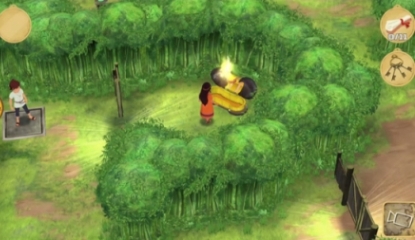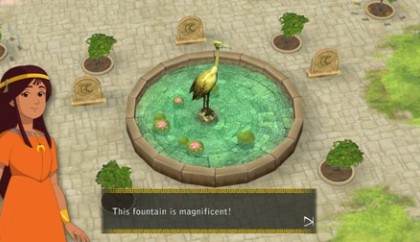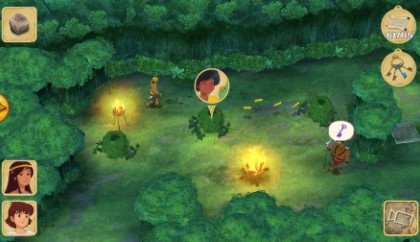The Mysterious Cities of Gold: Secret Paths Review
A large number of Nintendo 3DS owners will be too young to have watched The Mysterious Cities Of Gold in its original incarnation. A French-Japanese joint production, the series ran in the early 1980s and came to an end in 1983. Of course, repeat showings kept it relevant for much of that decade, but since then it has been largely forgotten. That was until a new version of the television series was launched last year, and has actually remained pretty true to the heart of the original. As could be expected, there is a tie-in video game.
The game follows the plot of Season Two of the re-launched cartoon pretty closely. Esteban, Zia and Tao (who all featured in the first run of the show) are searching the globe for the lost Cities of Gold, using the sun Medallion Esteban possesses as one of the Children of the Sun. We follow the group as they begin their search in China, and the game includes six worlds each made up of several smaller stages. The levels are punctuated by short cutscenes that make use of actual animated scenes from the series.
 Whilst these are nice to look at and tie the game into the series well, they are all very short and their excerpt nature makes the plot quite hard to follow – not that it’s particularly thrilling anyway. Strangely, although these cutscenes are great quality, and the general in-game art and animation are also strong, Secret Paths makes no use of 3D at all. This is probably more down to the multi-format nature of the game, but it seems strange that no attempt was made to integrate the technology.
Whilst these are nice to look at and tie the game into the series well, they are all very short and their excerpt nature makes the plot quite hard to follow – not that it’s particularly thrilling anyway. Strangely, although these cutscenes are great quality, and the general in-game art and animation are also strong, Secret Paths makes no use of 3D at all. This is probably more down to the multi-format nature of the game, but it seems strange that no attempt was made to integrate the technology.
The gameplay is puzzle-based, and makes use of the three main protagonists to present players with a series of co-operative brain-teasers. You can hot-switch between the three at will, and need to pick the right character and skills for each situation. For example, Zia can fit through smaller gaps as she is slim, Tao can translate ancient tablets for clues or use his pet Parrot Kokapetl to fetch objects, and Esteban can use his Sun Medallion to activate certain switches that the others cannot.
 Unfortunately, even though there are quite a few levels to play through, the conundrums are derivative and all amount to two or three basic puzzles dressed up slightly differently. Once you get the hang of it, they are all pretty repetitive and won’t cause you much trouble. Each stage has a selection of optional objectives in an attempt to add more of a challenge. These include a time goal, a number of scrolls to collect (some of which are colour-coded and can only be collected by a specific hero), and a capture count.
Unfortunately, even though there are quite a few levels to play through, the conundrums are derivative and all amount to two or three basic puzzles dressed up slightly differently. Once you get the hang of it, they are all pretty repetitive and won’t cause you much trouble. Each stage has a selection of optional objectives in an attempt to add more of a challenge. These include a time goal, a number of scrolls to collect (some of which are colour-coded and can only be collected by a specific hero), and a capture count.
As part of the puzzling, there are also stealth sections where our protagonists must sneak past dangerous pirates. This is pretty easy as they move in defined patterns and can only see directly in front of themselves, and because if you get spotted for a moment you’re allowed a few seconds to hide quickly, after which the pirates luckily seem to forget you were ever there. The only penalty for getting caught is a strike against your counter – which only effects your end-of-level score – so this takes away from the challenge a little. That said, if you repeatedly get caught, then completing the level in the target time and collecting all scrolls becomes increasingly harder.
 You can choose how to take control of things, using either stylus controls, which offer a more tactile experience for pushing buttons and moving boulders, but can be slightly imprecise when moving characters (particularly in stealth sections), or using the circle pad. Each player will likely have their own preference, but both work well. Perhaps touch controls will appeal to younger players more – who can also choose to have hint dialogue boxes pop-up to provide help – and older ones may like the precise button control. Either way, the controls certainly support all kinds of players.
You can choose how to take control of things, using either stylus controls, which offer a more tactile experience for pushing buttons and moving boulders, but can be slightly imprecise when moving characters (particularly in stealth sections), or using the circle pad. Each player will likely have their own preference, but both work well. Perhaps touch controls will appeal to younger players more – who can also choose to have hint dialogue boxes pop-up to provide help – and older ones may like the precise button control. Either way, the controls certainly support all kinds of players.
VERDICT: The Mysterious Cities of Gold: Secret Paths doesn’t fall into the usual trap of film and television adaptations, where it bears little or no relation to the source material. In fact, the storyline and adventuring themes of the cartoon are borne out through the gameplay pretty well. Whilst the title does sadly feel a bit too simple, Secret Paths possesses a lot of charm and tries to offer a range of challenges for all levels of skill. In the end it skews a little young overall, but that age group will also probably be more forgiving of the repetitive nature of the puzzles throughout the game.

DECENT. A 6/10 indicates that, while this game could be much better, it still has a fair amount to offer the player. It might be an interesting title sabotaged by its own ambition, or a game denied greater praise by some questionable design choices. Don’t avoid it outright, but approach it with caution.
Review code provided by publisher.




